Thanh-Dung Le
GLUSE: Enhanced Channel-Wise Adaptive Gated Linear Units SE for Onboard Satellite Earth Observation Image Classification
Apr 16, 2025Abstract:This study introduces ResNet-GLUSE, a lightweight ResNet variant enhanced with Gated Linear Unit-enhanced Squeeze-and-Excitation (GLUSE), an adaptive channel-wise attention mechanism. By integrating dynamic gating into the traditional SE framework, GLUSE improves feature recalibration while maintaining computational efficiency. Experiments on EuroSAT and PatternNet datasets confirm its effectiveness, achieving exceeding \textbf{94\% and 98\% accuracy}, respectively. While \textbf{MobileViT achieves 99\% accuracy}, ResNet-GLUSE offers \textbf{33x fewer parameters, 27x fewer FLOPs, 33x smaller model size (MB), $\approx$6x lower power consumption (W), and $\approx$3x faster inference time (s)}, making it significantly more efficient for onboard satellite deployment. Furthermore, due to its simplicity, ResNet-GLUSE can be easily mimicked for \textbf{neuromorphic computing}, enabling ultra-low power inference at just \textbf{852.30 mW} on Akida Brainchip. This balance between high accuracy and ultra-low resource consumption establishes ResNet-GLUSE as a practical solution for real-time Earth Observation (EO) tasks. Reproducible codes are available in our shared repository.
A Semantic-Loss Function Modeling Framework With Task-Oriented Machine Learning Perspectives
Mar 12, 2025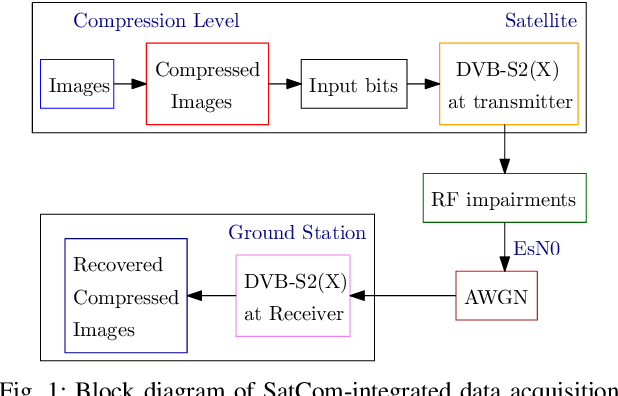
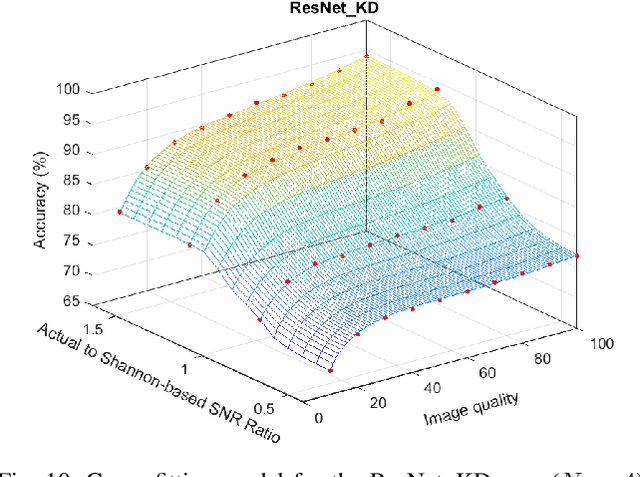
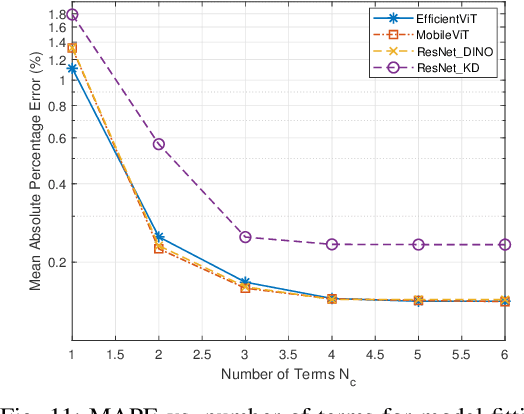
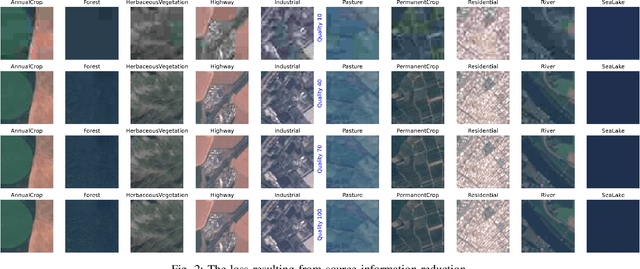
Abstract:The integration of machine learning (ML) has significantly enhanced the capabilities of Earth Observation (EO) systems by enabling the extraction of actionable insights from complex datasets. However, the performance of data-driven EO applications is heavily influenced by the data collection and transmission processes, where limited satellite bandwidth and latency constraints can hinder the full transmission of original data to the receivers. To address this issue, adopting the concepts of Semantic Communication (SC) offers a promising solution by prioritizing the transmission of essential data semantics over raw information. Implementing SC for EO systems requires a thorough understanding of the impact of data processing and communication channel conditions on semantic loss at the processing center. This work proposes a novel data-fitting framework to empirically model the semantic loss using real-world EO datasets and domain-specific insights. The framework quantifies two primary types of semantic loss: (1) source coding loss, assessed via a data quality indicator measuring the impact of processing on raw source data, and (2) transmission loss, evaluated by comparing practical transmission performance against the Shannon limit. Semantic losses are estimated by evaluating the accuracy of EO applications using four task-oriented ML models, EfficientViT, MobileViT, ResNet50-DINO, and ResNet8-KD, on lossy image datasets under varying channel conditions and compression ratios. These results underpin a framework for efficient semantic-loss modeling in bandwidth-constrained EO scenarios, enabling more reliable and effective operations.
Semantic Knowledge Distillation for Onboard Satellite Earth Observation Image Classification
Oct 31, 2024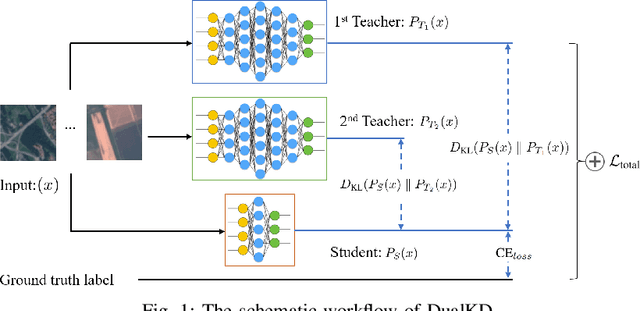
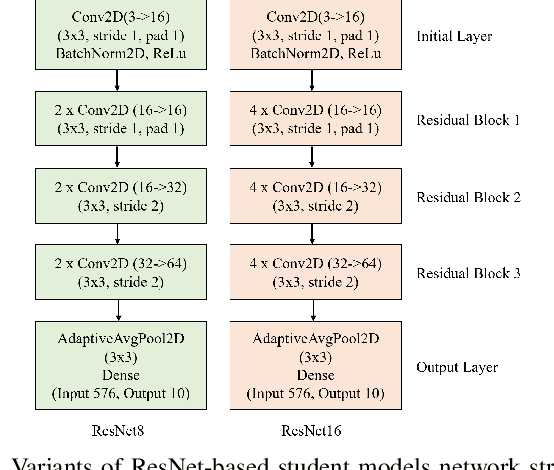
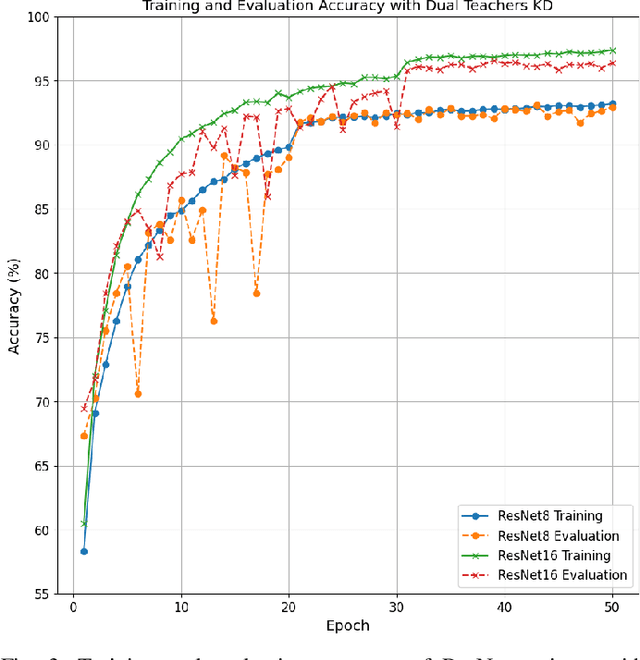
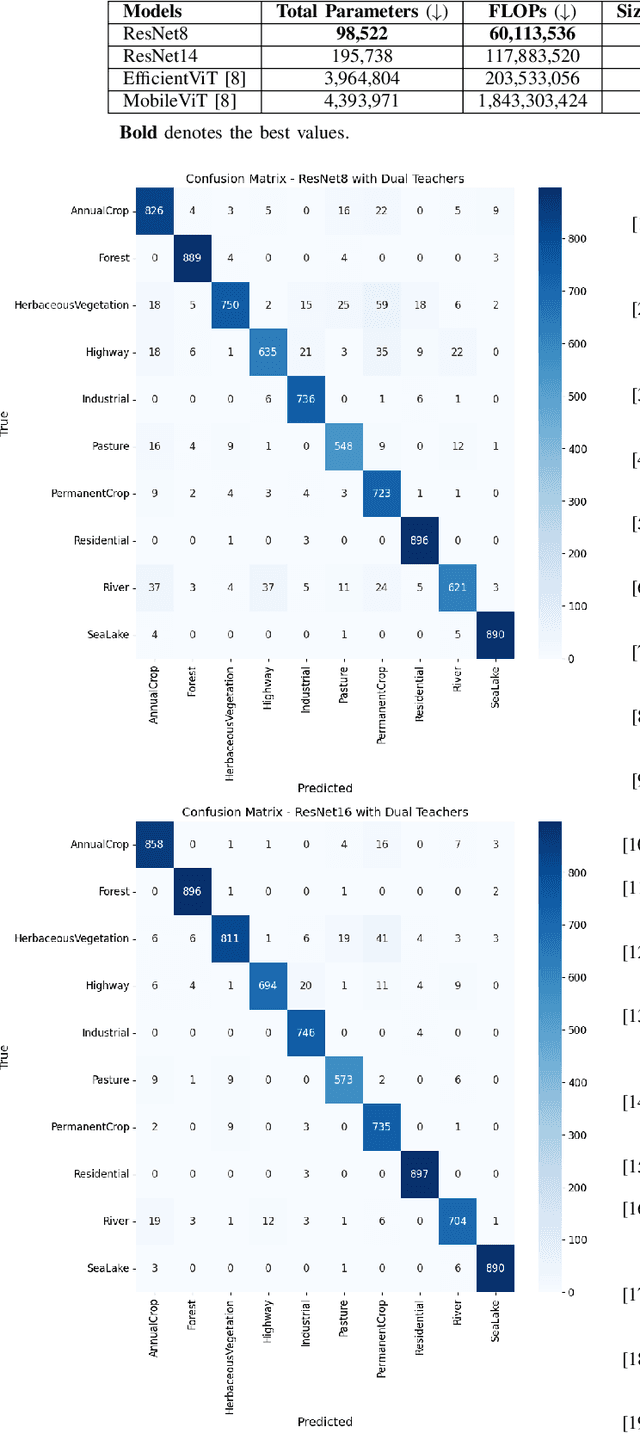
Abstract:This study presents an innovative dynamic weighting knowledge distillation (KD) framework tailored for efficient Earth observation (EO) image classification (IC) in resource-constrained settings. Utilizing EfficientViT and MobileViT as teacher models, this framework enables lightweight student models, particularly ResNet8 and ResNet16, to surpass 90% in accuracy, precision, and recall, adhering to the stringent confidence thresholds necessary for reliable classification tasks. Unlike conventional KD methods that rely on static weight distribution, our adaptive weighting mechanism responds to each teacher model's confidence, allowing student models to prioritize more credible sources of knowledge dynamically. Remarkably, ResNet8 delivers substantial efficiency gains, achieving a 97.5% reduction in parameters, a 96.7% decrease in FLOPs, an 86.2% cut in power consumption, and a 63.5% increase in inference speed over MobileViT. This significant optimization of complexity and resource demands establishes ResNet8 as an optimal candidate for EO tasks, combining robust performance with feasibility in deployment. The confidence-based, adaptable KD approach underscores the potential of dynamic distillation strategies to yield high-performing, resource-efficient models tailored for satellite-based EO applications. The reproducible code is accessible on our GitHub repository.
On-board Satellite Image Classification for Earth Observation: A Comparative Study of Pre-Trained Vision Transformer Models
Sep 05, 2024



Abstract:Remote sensing image classification is a critical component of Earth observation (EO) systems, traditionally dominated by convolutional neural networks (CNNs) and other deep learning techniques. However, the advent of Transformer-based architectures and large-scale pre-trained models has significantly shifted, offering enhanced performance and efficiency. This study focuses on identifying the most effective pre-trained model for land use classification in onboard satellite processing, emphasizing achieving high accuracy, computational efficiency, and robustness against noisy data conditions commonly encountered during satellite-based inference. Through extensive experimentation, we compared traditional CNN-based models, ResNet-based models, and various pre-trained vision Transformer models. Our findings demonstrate that pre-trained Transformer models, particularly MobileViTV2 and EfficientViT-M2, outperform models trained from scratch in accuracy and efficiency. These models achieve high performance with reduced computational requirements and exhibit greater resilience during inference under noisy conditions. While MobileViTV2 excelled on clean validation data, EfficientViT-M2 proved more robust when handling noise, making it the most suitable model for onboard satellite Earth observation tasks. In conclusion, EfficientViT-M2 is the optimal choice for reliable and efficient remote sensing image classification in satellite operations, achieving 98.76\% accuracy, precision, and recall. Specifically, EfficientViT-M2 delivered the highest performance across all metrics, excelled in training efficiency (1,000s) and inference time (10s), and demonstrated greater robustness (overall robustness score at 0.79).
The Impact of LoRA Adapters for LLMs on Clinical NLP Classification Under Data Limitations
Jul 27, 2024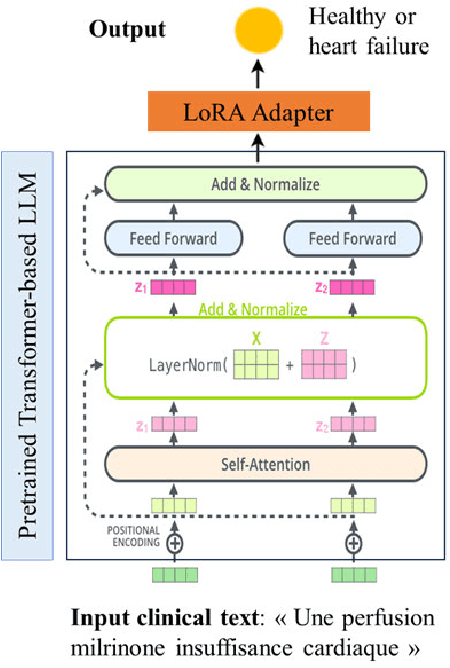

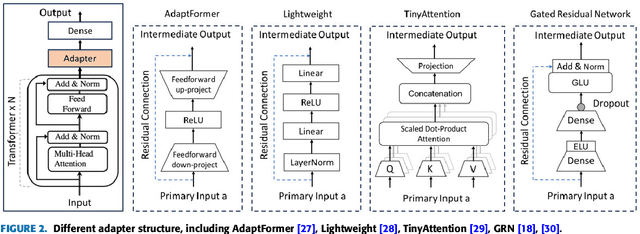
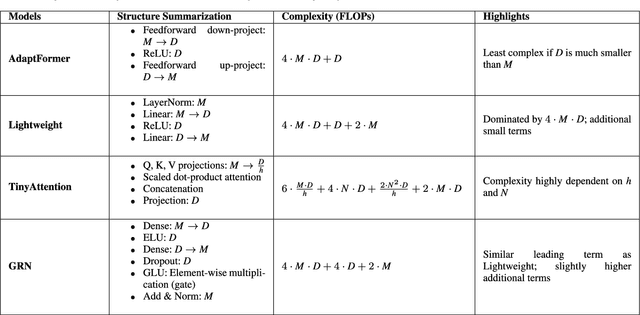
Abstract:Fine-tuning Large Language Models (LLMs) for clinical Natural Language Processing (NLP) poses significant challenges due to the domain gap and limited data availability. This study investigates the effectiveness of various adapter techniques, equivalent to Low-Rank Adaptation (LoRA), for fine-tuning LLMs in a resource-constrained hospital environment. We experimented with four structures-Adapter, Lightweight, TinyAttention, and Gated Residual Network (GRN)-as final layers for clinical notes classification. We fine-tuned biomedical pre-trained models, including CamemBERT-bio, AliBERT, and DrBERT, alongside two Transformer-based models. Our extensive experimental results indicate that i) employing adapter structures does not yield significant improvements in fine-tuning biomedical pre-trained LLMs, and ii) simpler Transformer-based models, trained from scratch, perform better under resource constraints. Among the adapter structures, GRN demonstrated superior performance with accuracy, precision, recall, and an F1 score of 0.88. Moreover, the total training time for LLMs exceeded 1000 hours, compared to under 6 hours for simpler transformer-based models, highlighting that LLMs are more suitable for environments with extensive computational resources and larger datasets. Consequently, this study demonstrates that simpler Transformer-based models can be effectively trained from scratch, providing a viable solution for clinical NLP tasks in low-resource environments with limited data availability. By identifying the GRN as the most effective adapter structure, we offer a practical approach to enhance clinical note classification without requiring extensive computational resources.
Hybrid Deep Learning-Based for Enhanced Occlusion Segmentation in PICU Patient Monitoring
Jul 18, 2024Abstract:Remote patient monitoring has emerged as a prominent non-invasive method, using digital technologies and computer vision (CV) to replace traditional invasive monitoring. While neonatal and pediatric departments embrace this approach, Pediatric Intensive Care Units (PICUs) face the challenge of occlusions hindering accurate image analysis and interpretation. \textit{Objective}: In this study, we propose a hybrid approach to effectively segment common occlusions encountered in remote monitoring applications within PICUs. Our approach centers on creating a deep-learning pipeline for limited training data scenarios. \textit{Methods}: First, a combination of the well-established Google DeepLabV3+ segmentation model with the transformer-based Segment Anything Model (SAM) is devised for occlusion segmentation mask proposal and refinement. We then train and validate this pipeline using a small dataset acquired from real-world PICU settings with a Microsoft Kinect camera, achieving an Intersection-over-Union (IoU) metric of 85\%. \textit{Results}: Both quantitative and qualitative analyses underscore the effectiveness of our proposed method. The proposed framework yields an overall classification performance with 92.5\% accuracy, 93.8\% recall, 90.3\% precision, and 92.0\% F1-score. Consequently, the proposed method consistently improves the predictions across all metrics, with an average of 2.75\% gain in performance compared to the baseline CNN-based framework. \textit{Conclusions}: Our proposed hybrid approach significantly enhances the segmentation of occlusions in remote patient monitoring within PICU settings. This advancement contributes to improving the quality of care for pediatric patients, addressing a critical need in clinical practice by ensuring more accurate and reliable remote monitoring.
Multi-objective Representation for Numbers in Clinical Narratives Using CamemBERT-bio
May 28, 2024



Abstract:This research aims to classify numerical values extracted from medical documents across seven distinct physiological categories, employing CamemBERT-bio. Previous studies suggested that transformer-based models might not perform as well as traditional NLP models in such tasks. To enhance CamemBERT-bio's performances, we introduce two main innovations: integrating keyword embeddings into the model and adopting a number-agnostic strategy by excluding all numerical data from the text. The implementation of label embedding techniques refines the attention mechanisms, while the technique of using a `numerical-blind' dataset aims to bolster context-centric learning. Another key component of our research is determining the criticality of extracted numerical data. To achieve this, we utilized a simple approach that involves verifying if the value falls within the established standard ranges. Our findings are encouraging, showing substantial improvements in the effectiveness of CamemBERT-bio, surpassing conventional methods with an F1 score of 0.89. This represents an over 20\% increase over the 0.73 $F_1$ score of traditional approaches and an over 9\% increase over the 0.82 $F_1$ score of state-of-the-art approaches. All this was achieved despite using small and imbalanced training datasets.
Transformer Meets Gated Residual Networks To Enhance Photoplethysmogram Artifact Detection Informed by Mutual Information Neural Estimation
May 25, 2024



Abstract:This study delves into the effectiveness of various learning methods in improving Transformer models, focusing particularly on the Gated Residual Network Transformer (GRN-Transformer) in the context of pediatric intensive care units (PICU) with limited data availability. Our findings indicate that Transformers trained via supervised learning are less effective compared to MLP, CNN, and LSTM networks in such environments. Yet, leveraging unsupervised and self-supervised learning on unannotated data, with subsequent fine-tuning on annotated data, notably enhances Transformer performance, although not to the level of the GRN-Transformer. Central to our research is the analysis of different activation functions for the Gated Linear Unit (GLU), a crucial element of the GRN structure. We also employ Mutual Information Neural Estimation (MINE) to evaluate the GRN's contribution. Additionally, the study examines the effects of integrating GRN within the Transformer's Attention mechanism versus using it as a separate intermediary layer. Our results highlight that GLU with sigmoid activation stands out, achieving 0.98 accuracy, 0.91 precision, 0.96 recall, and 0.94 F1 score. The MINE analysis supports the hypothesis that GRN enhances the mutual information between the hidden representations and the output. Moreover, the use of GRN as an intermediate filter layer proves more beneficial than incorporating it within the Attention mechanism. In summary, this research clarifies how GRN bolsters GRN-Transformer's performance, surpassing other learning techniques. These findings offer a promising avenue for adopting sophisticated models like Transformers in data-constrained environments, such as PPG artifact detection in PICU settings.
Heart Rate and Body Temperature Relationship in Children Admitted to PICU -- A Machine Learning Approach
Apr 30, 2024Abstract:Vital signs have been essential clinical measures. Among these, body temperature (BT) and heart rate (HR) are particularly significant, and numerous studies explored their association in hospitalized adults and children. However, a lack of in-depth research persists in children admitted to the pediatric intensive care unit (PICU) despite their critical condition requiring particular attention. Objective: In this study, we explore the relationship between HR and BT in children from 0 to 18 years old admitted to the PICU of CHU Sainte-Justine Hospital. Methods: We applied Machine learning (ML) techniques to unravel subtle patterns and dependencies within our dataset to achieve this objective. Each algorithm undergoes meticulous hyperparameter tuning to optimize the model performance. Results: Our findings align with prior research, revealing a consistent trend of decreasing HR with increasing patient age, confirming the observed inverse correlation. Furthermore, a thorough analysis identifies Gradient Boosting Machines (GBM) implemented with Quantile regression (QR), as the most fitting model, effectively capturing the non-linear relationship between HR, BT, and age. Through testing the HR prediction model based on age and BT, the predictive model between the 5th and 95th percentiles accurately demonstrates the declining trend of HR with age, while HR increase with BT. Based on that, we have developed a user-friendly interface tailored to generate HR predictions at different percentiles based on three key input parameters : current HR, current BT, and patient's age. The resulting output enables caregivers to quickly determine whether a patient's HR falls within or outside the normal range, facilitating informed clinical decision-making. Thus, our results challenge previous studies' presumed direct linear association between HR and BT.
Numerical Attributes Learning for Cardiac Failure Diagnostic from Clinical Narratives -- A LESA-CamemBERT-bio Approach
Apr 15, 2024Abstract:Medical records created by healthcare professionals upon patient admission are rich in details critical for diagnosis. Yet, their potential is not fully realized because of obstacles such as complex medical language, inadequate comprehension of medical numerical data by state-of-the-art Large Language Models (LLMs), and the limitations imposed by small annotated training datasets. This research aims to classify numerical values extracted from medical documents across seven distinct physiological categories, employing CamemBERT-bio. Previous studies suggested that transformer-based models might not perform as well as traditional NLP models in such tasks. To enhance CamemBERT-bio's performances, we introduce two main innovations: integrating keyword embeddings into the model and adopting a number-agnostic strategy by excluding all numerical data from the text. The implementation of label embedding techniques refines the attention mechanisms, while the technique of using a `numerical-blind' dataset aims to bolster context-centric learning. Another key component of our research is determining the criticality of extracted numerical data. To achieve this, we utilized a simple approach that involves verifying if the value falls within the established standard ranges Our findings are encouraging, showing substantial improvements in the effectiveness of CamemBERT-bio, surpassing conventional methods with an F1 score of 0.89. This represents an over 20\% increase over the 0.73 $F_1$ score of traditional approaches and an over 9\% increase over the 0.82 $F_1$ score of state-of-the-art approaches.
 Add to Chrome
Add to Chrome Add to Firefox
Add to Firefox Add to Edge
Add to Edge